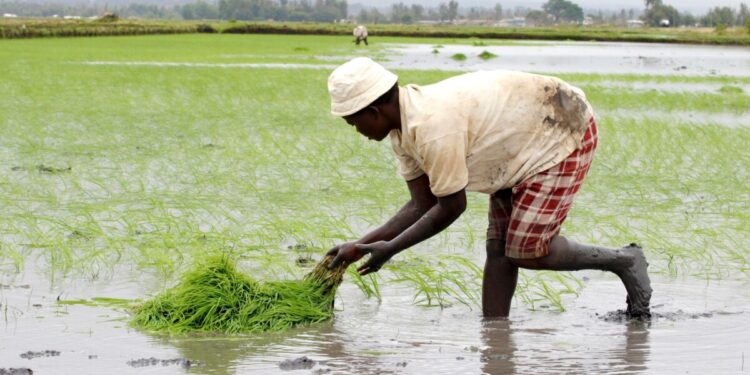- Experts are warning about the impact the Russian invasion of Ukraine will have on global food security.
- Between 720 million and 811 million people in the world faced hunger in 2020, around one in 10, according to UN estimates.
- COVID-19, climate change and conflict are among the main drivers of global food insecurity.
“Conflict and hunger are closely intertwined – when one escalates, the other usually follows. As in any crisis, it is the poorest and most vulnerable who are hardest hit, and in our globalized world, the impact of this conflict will reverberate across continents.”
These are the words of Gilbert Houngbo, former Prime Minister of Togo now President of the United Nations’ International Fund for Agricultural Development (IFAD).
As the crisis in Ukraine deepens, experts including Houngbo are warning about the impact of the Russian invasion on global food security.
IFAD is “very concerned” that an extended conflict in Ukraine could limit the world’s supply of staple crops such as wheat, corn and sunflower oil, resulting in skyrocketing food prices and hunger, he adds.
“This could jeopardize global food security and heighten geopolitical tensions.”
What is the current state of global food security?
Two years of the COVID-19 pandemic have already taken a considerable toll on global food systems – and the ability of the world to feed its 7.9 billion people.
Ending hunger is the second of the UN’s 17 Sustainable Development Goals to achieve by 2030.
In the 2021 State of Food Security and Nutrition in the World report – a collaboration between five UN agencies – the authors recognize that achieving this goal has become more challenging.
Between 720 million and 811 million people in the world faced hunger in 2020, around one in 10, according to UN estimates – and roughly 70 million to 161 million more people faced hunger in 2020 than in 2019.
Some regions are more affected than others. About one in five people in Africa (21%) faced hunger in 2020 – more than double the proportion of any other region and a 3 percentage point increase in one year, the report says.
In Latin America and the Caribbean, one in 10 people faced hunger in 2020.
Malnutrition affects how children grow. In 2020, about 22% of under-fives – or just over 149 million – suffered from stunting, and nearly three-quarters of children with such impaired growth lived in just two regions: Central and Southern Asia (37%) and sub-Saharan Africa (37%).
What impact will the Ukraine invasion have on global food security?
Ukraine plays a major role in the global food system. Together with Russia, the two countries account for a combined 12% of the food calories traded in the world, says IFAD.
Almost half (40%) of Ukraine’s wheat and corn exports go to the Middle East and Africa, which are already grappling with hunger issues, and where further food shortages or price increases could stoke social unrest.
Egypt is the world’s biggest buyer of wheat and imports most of this from Ukraine and Russia. It uses the grain to make subsidized bread, on which many families rely, according to The Economist.
“The continuation of this conflict, already a tragedy for those directly involved, will be catastrophic for the entire world, and particularly those that are already struggling to feed their families,” says Houngbo.
“IFAD is committed to continue its work to increase the food self-sufficiency and resilience of the world’s poorest countries, but in the short term it will be difficult to mitigate the global impacts of this crisis. Stopping the conflict now is the only solution.”
Global food prices rose by over 20% in February compared with a year earlier, taking them to record levels, according to the UN’s Food and Agriculture Organization.
How can we end world hunger and food insecurity?
The UN agencies’ report, published before the invasion of Ukraine, recommends six ways to transform food systems to address these challenges and “ensure access to affordable healthy diets for all, sustainably and inclusively”.
1. Integrating humanitarian, development and peacebuilding policies in conflict-affected areas.
2. Scaling up climate resilience across food systems.
3. Strengthening the resilience of the most vulnerable to economic adversity.
4. Intervening along the food supply chains to lower the cost of nutritious foods.
5. Tackling poverty and structural inequalities, ensuring interventions are pro-poor and inclusive.
6. Strengthening food environments and changing consumer behaviour to promote dietary patterns with positive impacts on human health and the environment.
The World Economic Forum, the Food Action Alliance and partners are holding a virtual meeting, ”Bold Actions for Food – Regional and Country Flagships”, to drive action on food systems change.
In the opening plenary, leaders will discuss how to raise ambitions and scale up leadership action this year towards COP27, and explore strategies for realizing shared goals by 2030.
Key topics to be addressed include the global outlook for 2022; rising food insecurity and market volatility; enabling countries to take on integrated transitions across food, nature and health; and unlocking policy, innovation and finance levers to scale solutions.
(Courtesy World Economic Forum)












